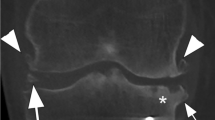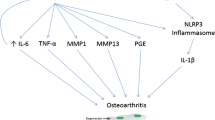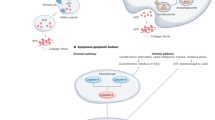Abstract
The clinical implication of articular deposits of calciumcontaining crystals (specifically of calcium pyrophosphate dihydrate and hydroxyapatite) in osteoarthritis is unknown. Recent longitudinal studies have suggested that in some instances calcium crystals are direct participants in cartilage damage, while in other situations they are merely markers of joint damage. Better understanding of the mechanisms of crystal formation, especially in relation to inorganic pyrophosphate regulation, has lead to potential avenues for therapeutic intervention. The current treatment of osteoarthritis associated with calcium-containing crystals should involve nonsteroidal anti-inflammatory drugs, intra-articular steroids, and in resistant cases, joint irrigation can be considered. While preliminary studies suggest the possibility of favorable benefits from colchicine and hydroxycholorquine in this osteoarthritis disease subset, more rigorous studies need to be conducted to establish their roles.
Similar content being viewed by others
References and Recommended Reading
Gibilisco P, Schumacher R, Hollander J, Soper K: Synovial fluid crystals in osteoarthritis. Arthritis Rheum 1985, 5:511–515.
Derfus BA, Kurian JB, Butler JJ, et al.: The high prevalence of pathologic calcium crystals in preoperative knees. J Rheumatol 2002, 29:570–574. This study clearly showed higher radiographic scores in patients with calcium-containing crystals in the knees of patients undergoing total arthroplasty.
Nalbant S, Martinez J, Kitummuaypong T, et al.: Synovial fluid features and their relations to osteoarthritis severity: new findings from sequential analysis. Osteoarthritis Cartilage 2003, 11:50–54. This sequential analysis of synovial fluid from patients with knee OA demonstrated that in some cases, calcium crystals appear with progression of the disease.
Halverson PB, McCarty DJ: Identification of hydroxyapatite crystals in synovial fluid. Arthritis Rheum 1979, 22:389–395.
Reuge L, Van Linthoudt D, Gerster J-Ch: Local deposition of calcium pyrophosphate crystals in evolution of knee osteoarthritis. Clin Rheumatol 2001, 20:428–431.
Jaovisidha K, Rosenthal A: Calcium crystals in osteoarthritis. Curr Opin Rheumatol 2002, 14:298–302.
Rosenthal AK, Mandel N: Identification of crystals in synovial fluids and joint tissue. Curr Rheumatol Rep 2001, 3:11–16. This is a nice review of the techniques utilized to identify crystals in synovial fluid and the shortcomings of each method.
Kalunian K, Moreland L, Klashman D, et al.: Visually-guided irrigation in patients with early knee osteoarthritis: a multicenter randomized, controlled trial. Osteoarthritis Cartilage 2000, 8:412–418. This study demonstrated a potential benefit of joint irrigation in the subset of knee OA patients who have crystals.
Ryan LM, Cheung HS: The role of crystals in osteoarthritis. Rheum Dis Clin North Am 1999, 25:257–267.
Beltran J, Marty-Delfaut E, Bencardino J, et al.: Chondrocalcinosis of the hyaline cartilage of the knee: MRI manifestations. Skeletal Radiol 1998, 27:369–374.
Abreu M, Johnson K, Chung C, et al.: Calcification in calcium pyrophosphate dihydrate crystalline deposits in the knee: anatomic, radiographic, MR imaging, and histologic study in cadavers. Skeletal Radiol 2004, 33:392–398.
Foldes K: Knee chondrocalcinosis: an ultrasonographic study of the hyaline cartilage. J Clin Imag 2002, 26:194–196.
Sofka C, Adler R, Cordasco F: Ultrasound diagnosis of chondrocalcinosis of the knee. Skeletal Radiol 2002, 31:43–45.
Terkeltaub R: What does cartilage calcification tell us about osteoarthritis? J Rheumatol 2002, 29:411–415.
Schumacher R: The role of inflammation and crystals in the pain of osteoarthritis. Semin Arth Rheum 1989, 18:81–85.
Ohira T, Ishikawa K: Hydroxyapatite deposition in osteoarthritic articular cartilage of the proximal femoral head. Arthritis Rheum 1987, 30:651–660.
Concoff A, Kalunian K: What is the relationship between crystals and osteoarthritis? Curr Opin Rheumatol 1999, 11:436–440.
Anderson H: Matrix vesicles and calcification. Curr Rheumatol Rep 2003, 5:222–226.
Pay S, Terkeltaub R: Calcium pyrophosphate dihydrate and hydroxyapatite crystal deposition in the joint: new developments relevant to the clinician. Curr Rheumatol Rep 2003, 5:235–243.
Johnson K, van Etten D, Nanda N, et al.: Distinct transglutaminase 2-independent and transglutaminase 2-dependent pathways mediate articular chondrocyte hypertrophy. J Biol Chem 2003, 278:18824–18832.
Kirsch T, Swoboda B, Nah H: Activation of annexin II and V expression, terminal differentiation, mineralization and apoptosis in human osteoarthritic cartilage. Osteoarthritis Cartilage 2000, 8:294–302.
Johnson K, Terkeltaub R: Upregulated ank expression in osteoarthritis can promote both chondrocyte MMP-13 expression and calcification via chondrocyte extracellular PPi excess. Osteoarthritis Cartilage 2004, 12:321–335. This study demonstrated that elevation of ecPPi by ANK critically requires the fraction of cellular PPi generated by PC-1. Increased ANK promote matrix loss, suggesting that increased ANK expression and ecPPi exert noxious effects in degenerative arthropathies beyond stimulation of calcification.
Ho AM, Johnson MD, Kingsley DM: Role of the mouse ank gene in control of tissue calcification and arthritis. Science 2000, 289:265–269. This work demonstrated that the multipass transmembrane protein (ANK) was encoded by the gene mutated in the hyperostotic murine progressive ankylosis ANK/ANK mice; ANK was identified to regulate intracellular to extracellular transport of PPi.
Pendleton A, Johnson MD, Hughes A, et al.: Mutations in ANKH cause chondrocalcinosis. Am J Hum Genet 2002, 71:933–940. The authors reported linkage of mutations near the N-terminal of the ANKH gene in certain kindred with familial chondrocalcinosis.
Williams JC, Zhang Y, Timms A, et al.: Autosomal dominant familial calcium pyrophosphate dihydrate deposition disease is caused by mutation in the transmembrane protein ANKH. Am J Hum Genet 2002, 71:985–991. The authors reported linkage of the P5L mutation in ANKH to autosomal dominant chondrocalcinosis in an Argentine family of Northern Italian decent.
Terkeltaub R: Inorganic pyrophosphate generation and disposition in pathophysiology. AJP Cell Physiol 2001, 281:C1-C11. This comprehensive review summarizes recent developments in the understanding of the generation and disposal of PPi and discussed the role of PPi metabolism in diseases with connective tissue calcification.
Johnson K, Hashimoto S, Lotz M, et al.: Interleukin-1 induces pro-mineralizing activity of cartilage tissue transglutaminase and factor XIIIa. Am J Pathol 2001, 159:149–163. This study links stimulation of articular inflammation to a pro-mineralizing pathway whose activation increases with aging in cartilage.
Rosenthal AK, Drefus BA, Henry LA: Transglutimase activity in aging articular chondrocytes and articular cartilage vescilcles. Arthritis Rhuem 1997, 40:966–970.
Rosen F, McCabe G, Quach J, et al.: Differential effects of aging on human chondrocyte responses to transforming growth factor beta: increased pyrophosphate production and decreased cell proliferation. Arthritis Rheum 1997, 40:1275–1281.
Liu R, O’Connel M, Johnson K, et al.: Extracellular signalregulated kinase 1/extracellular signal-regulated kinase 2 mitogen-activated protein kinase signaling and activation of activator protein 1 and nuclear factor kappaB transcription factors play central roles in interleukin-8 expression stimulated by monosodium urate monohydrate and calcium pyrophosphate crystals in monocytic cells. Arthritis Rheum 2000, 4:1145–1155.
Schumacher H Jr, Fishbein P, Phelps P, Krausner R: Comparison of soium urate and calcium pyrophosphate crystal phagocytosis by polymorphonuclear leukocytes: effects of crystal size and other factors. Arthritis Rheum 1975, 18:783–792.
Nagase M, Baker D, Schumacher H Jr: Immunoglobulin G coating on crystals and ceramics enhances polymorphonuclear cell superoxide production: correlation with IgG absorbed. J Rheumatol 1989, 16:971–976.
Pritzker K: Osteoarthritis and calcium pyrophosphate dihydrate crystal arthropathy [abstract]. Osteoarthritis Cartilage 2004, 12:S51.
Bardin T, Bucki B, Lansman J, et al.: Calcium crystals and rapidly destructive osteoarthritis. Osteoarthritis Cartilage 1993, 1:15.
Fam A, Morava-Protzner I, Purcell C, et al.: Acceleration of experimental lapine osteoarthritis by calcium pyrophosphate microcrystalline synovitis. Arthritis Rheum 1995, 38:201–210.
Cheung H, Story M, McCarty D: Mitogenic effecets of hydroxyapatite and calcium pyrophosphate dihydrate crystal on cultured mammalian cells. Arthritis Rheum 1984, 27:668–674.
Bonnet CS, Walsh A: Osteoarthritis, angiogenesis and inflammation. Rheumatology (Oxford) 2005, 44:7–16. This is a nice review of the mechanisms that drive the interdependence between angiogenesis and inflammation in OA.
McCarthy G, Cheung H, Abel S, Ryan L: Basic calcium phosphate crystal-induced collagenase production: role of intracellular crystal dissolution. Osteoarthritis Cartilage 1998, 6:205–213.
Brogley MA, Cruz M, Cheung H: Basic calcium phosphate crystal induction of collagenase 1 and stromelysin expression is dependent on a p42/44 mitogen-activated protein kinase signal transduction pathway. J Cell Physiol 1999, 180:215–224.
Morgan MP, Whelan LC, Sallis JD, et al.: Basic calcium phosphate crystal-induced prostaglandin E2 production in human fibroblasts: role of cyclooxygenase 1, cyclooxygenase 2, and interleukin-1beta. Arthritis Rheum 2004, 50:1642–1649.
Guerne PA, Terkeltaub R, Zuraw B, Lotz M: Inflammatory micro-crystals stimulate interleukin-6 production and secretion by human monocytes and synoviocytes. Arthritis Rheum 1989, 32:1443–1452.
Pelletier JP, Martel-Pelletier J, Abramson S: Osteoarthritis, an inflammatory disease. Arthritis Rheum 2001, 44:1237–1247.
Liu-Bryan R, Pritzker K, Firestein GS, Terkeltaub R: TLR2 signaling in chondrocytes drives calcium pyrophosphate dihydrate and monosodium urate crystal-induced nitric oxide generation. J Immunology 2005, In press. One of the first papers to describe a link between the innate immune system and calcium crystals. CPPD crystals were shown to trigger oxide production dependent on the TLR2 signaling cascade in chondrocytes.
Wright G, Doherty M: Calcium pyrophosphate crystal deposition is not always ‘wear and tear’ or aging. Ann Rheum Dis 1997, 56:586–588.
Wu DW, Reginato AJ, Torriani M, et al.: The crowned dens sydrome as a cause of neck pain: report of two new cases and a review of the literature. Arthritis Rheum 2005, 53:133–137.
American College of Rheumatology Subcommittee on Osteoarthritis Guidelines: Recommendations for the medical management of osteoarthritis of the hip and knee: 2000 update. Arthritis Rheum 2000, 43:1905.
Amin AR, Attur M, Patel RN, et al.: Superinduction of cyclooxygenase-2 activity in human osteoarthritis-affected cartilage. Influence of nitric oxide. J Clin Invest 1997, 99:1231–1237.
Alvarellos A, Spilberg I: Colchicine prophylaxis in pseudogout. J Rheumatol 1986, 13:804–805.
Das SK, Mishra K, Ramakrishnan S, et al.: A randomized controlled trial to evaluate the slow-acting symptom modifying effects of a regimen containing colchicine in a subset of patients with osteoarthritis of the knee. Osteoarthritis Cartilage 2002, 10:247–252.
Das SK, Ramakrishnan S, Mishra K, et al.: A randomized controlled trial to evaluate the slow-acting symptom modifying effects of colchicine in osteoarthritis of the knee: a preliminary report. Arthritis Care Res 2002, 47:280–284.
Bryant LR, des Rosier KF, Carpenter MT: Hydroxychloroquine in the treatment of erosive osteoarthritis. J Rheumatol 1995, 22:1527–1531.
Watanabe M: Articular pumping. J Jap Ortop Ass 1949, 24:30.
Bradley JD, Heilman DK, Katz BP, et al.: Tidal irrigation as treatment for knee osteoarthritis: a sham-controlled, randomized, double-blinded evaluation. Arthritis Rheum 2002, 46:100.
Moseley JB, O’Malley K, Petersen NJ, et al.: A controlled trial of arthroscopic surgery for osteoarthritis of the knee. N Engl J Med 2002, 347:81–88. This randomized, blinded study of 180 patients with knee OA found no significant advantage in the reduction of pain or improvement in function in the groups that received arthroscopic intervention versus the sham group.
Klashman DJ, Moreland LW, Ike RW, Kalunian KC: Occult presence of CPPD crystals in patients undergoing arthroscopic knee irrigation for refractory pain related to osteoarthritis [abstract]. Arthritis Rheum 1994, 37:S240.
Newstadt DH: Intraarticular steroid therapy. In Osteoarthritis: Diagnosis and Medical/Surgical Management. Edited by Moskowitz RW, Howell DS, Goldberg VM, Mankin HJ. Philadelphia: WB Saunders Co; 1992:493.
Arroll B, Goodyear-Smith F: Corticosteroid injections for osteoarthritis of the knee: meta-analysis. BMJ 2004, 328:869.
Raynauld JP, Buckland-Wright C, Ward R, et al.: Safety and efficacy of long-term intraarticular steroid injections in osteoarthritis of the knee: a randomized, double-blind, placebo-controlled trial. Arthritis Rheum 2003, 48:370–377.
Sallis J, Cheung H: Inhibitors of articular calcium crystal formation. Curr Opin Rheumatol 2003, 15:321–325.
Ito G, Suzuki Y, Uehara R, et al.: Beneficial effect of high-dose etidronate on periarticular calcinosis associated with arterial and periarticular basic calcium phosphate (BCP) crystal deposition disease. Ryumachi 2003, 43:644–648.
Young-Min SA, Herbert L, Dick M, Fordham J: Weekly alendronate-induced acute pseudogout. Rheumatology (Oxford) 2005, 44:131–132.
Malnick SD, Ariel-Ronen S, Evron E, Sthoeger ZM: Acute pseudogout as a complication of pamidronate. Ann Pharmacother 1997, 31:499–500.
Author information
Authors and Affiliations
Rights and permissions
About this article
Cite this article
Wu, C.W., Terkeltaub, R. & Kalunian, K.C. Calcium-containing crystals and osteoarthritis: Implications for the clinician. Curr Rheumatol Rep 7, 213–219 (2005). https://doi.org/10.1007/s11926-996-0042-2
Issue Date:
DOI: https://doi.org/10.1007/s11926-996-0042-2




